Terrestrial ecosystems
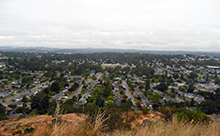 Even though the Bowker Creek watershed is now highly urbanized, it still hosts some areas of native plants and wildlife. The watershed is located in the Coastal Douglas-fir (CDF) biogeoclimatic zone. The natural vegetation of this ecosystem includes:
Even though the Bowker Creek watershed is now highly urbanized, it still hosts some areas of native plants and wildlife. The watershed is located in the Coastal Douglas-fir (CDF) biogeoclimatic zone. The natural vegetation of this ecosystem includes:
- Trees such as Douglas-fir (Pseudotsuga menziesii), western flowering dogwood (Cornus nutallii), black cottonwood (Populus balsamifera), western redcedar (Thuja plicata), bigleaf maple (Acer macrophyllum) and arbutus (Arbutus menziesii);
- Shrubs such as Nootka rose (Rosa nutkana), common snowberry (Symphoricarpos albus), salal (Gaultheria shallon), Oregon grape (Mahonia sp.), willows (Salix sp.), red-osier dogwood (Cornus stolonifera), kinnickinnick (Arctostaphylos uva-ursi) and Indian plum (Oemleria cerasiformis);
- Herbaceous plants such as ferns, grasses, and many species of perennials.
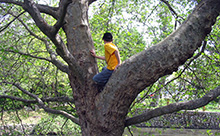 Garry oak meadows are a sub-component of CDF forests. Once common around Victoria, southern Vancouver Island and on some Gulf Islands, they are now limited to small areas among urban and agricultural land. Garry Oak meadows host a wide variety of rare and endangered species of plants and wildlife. An example of a Garry Oak meadow in the Bowker Creek watershed can be found on the northern slopes of Mt. Tolmie.
Garry oak meadows are a sub-component of CDF forests. Once common around Victoria, southern Vancouver Island and on some Gulf Islands, they are now limited to small areas among urban and agricultural land. Garry Oak meadows host a wide variety of rare and endangered species of plants and wildlife. An example of a Garry Oak meadow in the Bowker Creek watershed can be found on the northern slopes of Mt. Tolmie.
Many invasive non-native plant species are now present in this watershed. Scotch broom (Cytisus scoparius), Himalayan blackberry (Rubus discolor) and English ivy (Hedera helix) are three of the most common invasive plants in the Bowker Creek watershed. Nevertheless, the pockets of native plants remaining in the watershed provide valuable food and refuge for wildlife such as birds and small mammals. The goal of creating more public green space along Bowker Creek, as outlined in the Watershed Management Plan, will also provide an opportunity to increase wildlife habitat, particularly if invasive plants are removed and native species re-introduced wherever possible.
Freshwater ecosystems
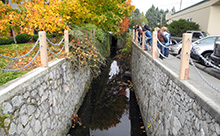 The aquatic ecosystems in Bowker Creek are limited for the most part to invertebrates such as insect larvae and worms, with the exception of a few fish that live near the mouth of the creek. Water quality has been found to be “acceptable” for aquatic life, so the condition of the creek channel is believed to be the main limiting factor to fish habitat. The underground storm drains support very little life, as they don’t receive the sunlight required for plant and algae growth.
The aquatic ecosystems in Bowker Creek are limited for the most part to invertebrates such as insect larvae and worms, with the exception of a few fish that live near the mouth of the creek. Water quality has been found to be “acceptable” for aquatic life, so the condition of the creek channel is believed to be the main limiting factor to fish habitat. The underground storm drains support very little life, as they don’t receive the sunlight required for plant and algae growth.
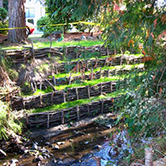 The open sections are exposed to sunlight but have very few sheltered places for plants to grow and fish to live, since they are so straight and deep. In a natural stream, obstacles such as rocks, large fallen trees, and bends in the channel help to slow down the water and create sheltered pools. In Bowker Creek, rainwater flows off the surrounding impervious surfaces and rushes down the channel with tremendous energy. This causes flooding and erosion of the stream banks, and creates an inhospitable environment for fish.
The open sections are exposed to sunlight but have very few sheltered places for plants to grow and fish to live, since they are so straight and deep. In a natural stream, obstacles such as rocks, large fallen trees, and bends in the channel help to slow down the water and create sheltered pools. In Bowker Creek, rainwater flows off the surrounding impervious surfaces and rushes down the channel with tremendous energy. This causes flooding and erosion of the stream banks, and creates an inhospitable environment for fish.
Future stream restoration will likely focus on reducing impervious surfaces, increasing infiltration of rainwater into the ground, and mimicking natural features in the stream channel, such as floodplains and wetlands. These strategies will improve the overall ecology and function of the stream.
In 2020, Friends of Bowker Creek initiated the Chum Salmon Recovery program with the goal of restoring chum salmon to the lower reaches of Bowker Creek. Contact Friends of Bowker Creek for more information.
Riparian ecosystems
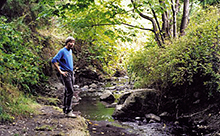 Riparian ecosystems are found in the transition zone between upland (terrestrial) ecosystems and the aquatic ecosystems. Saturated soils typical of riparian areas allow specialized plants and microbes to flourish, creating a very productive environment. These ecosystems also soak up excess water during floods, helping to prevent downstream damage, and filter contaminants that are washed off urban surfaces. Unfortunately, very few natural riparian zones are left along Bowker Creek. When the stream was artificially deepened to facilitate land drainage, it became disconnected with its floodplain. Consequently, the water table (the subsurface water level) fell and riparian areas were transformed into drier terrestrial ecosystems. A couple of remnant wetland riparian ecosystems are located at the headwaters on the University of Victoria grounds and along a tributary of the main channel at the Cedar Hill Golf Course.
Riparian ecosystems are found in the transition zone between upland (terrestrial) ecosystems and the aquatic ecosystems. Saturated soils typical of riparian areas allow specialized plants and microbes to flourish, creating a very productive environment. These ecosystems also soak up excess water during floods, helping to prevent downstream damage, and filter contaminants that are washed off urban surfaces. Unfortunately, very few natural riparian zones are left along Bowker Creek. When the stream was artificially deepened to facilitate land drainage, it became disconnected with its floodplain. Consequently, the water table (the subsurface water level) fell and riparian areas were transformed into drier terrestrial ecosystems. A couple of remnant wetland riparian ecosystems are located at the headwaters on the University of Victoria grounds and along a tributary of the main channel at the Cedar Hill Golf Course.
Marine ecosystems
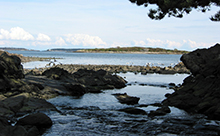 Bowker Creek discharges into Oak Bay, a rich marine environment. Water quality in the creek can have a direct effect (either positive or negative) on the marine ecosystems that receive creek flows. The bay contains a marina, and is fringed by rocky shorelines and sand and gravel beaches. Many different species of seabirds, shorebirds and waterfowl often feed in the bay itself, while others, such as cormorants and gulls, breed on the Chain Islands and the Chatham-Discovery Group located a few kilometres east of Oak Bay. Harbour seals are also common in the bay. Strong tides and cold water offshore constantly flush through the Juan de Fuca Strait, bringing a steady supply of nutrients to the kelp beds anchored to the many rocky islets, and creating a favourable environment for many types of fish. Orcas are occasionally sighted in the deeper waters.
Bowker Creek discharges into Oak Bay, a rich marine environment. Water quality in the creek can have a direct effect (either positive or negative) on the marine ecosystems that receive creek flows. The bay contains a marina, and is fringed by rocky shorelines and sand and gravel beaches. Many different species of seabirds, shorebirds and waterfowl often feed in the bay itself, while others, such as cormorants and gulls, breed on the Chain Islands and the Chatham-Discovery Group located a few kilometres east of Oak Bay. Harbour seals are also common in the bay. Strong tides and cold water offshore constantly flush through the Juan de Fuca Strait, bringing a steady supply of nutrients to the kelp beds anchored to the many rocky islets, and creating a favourable environment for many types of fish. Orcas are occasionally sighted in the deeper waters.